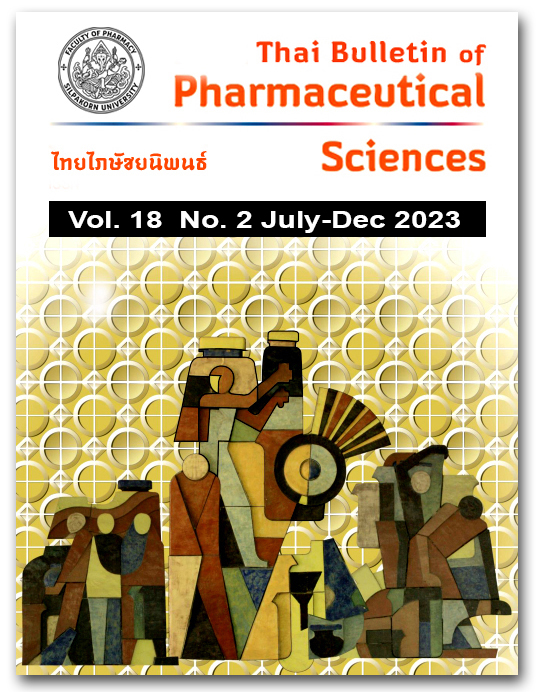FACTORS RELATED TO VEGETABLES AND FRUITS SAFETY IN PACKING SITES: A CASE STUDY IN PATHUMTHANI PROVINCE
DOI:
https://doi.org/10.69598/tbps.18.2.49-67Keywords:
vegetable and fruit safety, vegetable and fruit packing site, pesticides, factors, knowledgeAbstract
In the present descriptive study, an effort has been made to evaluate pesticide residues and determine factors related to fruit and vegetable safety of packing sites. Surveys containing information of respondents and packing sites, knowledge of safety and legal knowledge were conducted at 96 authorized packing sites, completed by each facility's owner or person responsible for packing. Additionally, one sample of fruit or vegetable was randomly collected from each facility for pesticide residue testing by GPO-M kit between December 2021 - February 2022. Analyzed data by descriptive statistics, as well as chi-square or Fisher tests were used to analyze factors related to safety. Statistical significance was set at 0.05 level. The results indicated that the washing was the least followed safety process. The study of knowledge about safety found that an average of 12 ± 2.8 points out of 14 points. The question about pesticides had the least correct answers. In terms of legal knowledge found that an average of 4.7 ± 1.9 points out of 6 points. The question about the offense in case of residue exceeding standard had the least correct answers. The preliminary test using GPO-M kit found residues at unsafe or toxic levels in 12.5% of samples. Upon analyzing factors relevant to safety, it was determined that the previously reported data on detecting pesticide residues by Pathum Thani Provincial Public Health Office exhibited a statistically significant correlation (p-value = 0.041) with the safety of fruits and vegetables at packing site. Based on results, it is proposed that operators should adhere to fruit and vegetable safety measures. Therefore, safety procedures, acquire knowledge about safety and laws. Continuous monitoring of pesticide residues by Pathum Thani Public Health Office is recommended. Knowledge of safety, legal regulations and safety procedures should be provided to operators of packing sites.
References
Thai Health Reform Foundation (TRF). Thai farmers risk getting sick with pesticide poisoning in 2018, almost 10,000 people [internet]. Udon Thani: The Foundation; c2019 [updated 2019 Jun 25; cited 2021 Nov 30]. Available from: https://hfocus.org/content/2019/06/17297 (in Thai)
Ministry of Public Health. Notification of the Ministry of Public Health No.386, B.E. 2560: prescription of production process, equipment and utensil for production and storage of some fresh fruits or vegetables and labeling. Government Gazette. Number 134, Special Section 211 D (2017 Aug 25). p.20-21. (in Thai)
Food and Drug Administration, Rural and Local Consumer Health Products Promotion Protection Division. KPIs, activities, datasets, report forms and budget of the implementation of consumer protection for health products in the regions fiscal year 2017. Nonthaburi: The Division; 2017. (in Thai)
Thailand Pesticide Alert Network. Vegetable examination results [internet]. Nonthaburi: The Network; c2020 [cited 2021 Nov 30]. Available from: https://thaipan.org/tags/ผลการตรวจผัก (in Thai)
Pathumthani Provincial Public Health Office. Surveillance situation of pesticide residues in Pathumthani province. Pathumthani: The Office; 2021. (in Thai)
Aroonrangsikul C. Product safety standards project throughout the production chain to support the strategy food safety vegetable: a complete research report. Bangkok: Thailand Research Fund; 2013. (in Thai)
Food and Drug Administration. Bureau of Food. Manual for inspecting production sites (sorting and packing) fresh fruits and vegetables according to the criteria, production process, equipment and utensil for production and storage of some fresh fruits or vegetables. Nonthaburi: The Bureau; 2017. (in Thai)
Government Pharmaceutical Organization (GPO). Chemical screening sets in vegetables, fruits and cereals (2 groups) GPO-M kit. Bangok: GPO; 2012. (in Thai)
Food and Drug Administration. Bureau of Food. Surveillance situation of some fruits and vegetables safety in Thailand. Nonthaburi: The Bureau; 2016. (in Thai)
Panyasiri T, Manunpol K, Vimolpeerapatthana W, Boodyee C. Study on factors involving safety of fresh fruits and vegetables sold in domestic market and recommendation on control measures for ensuring safety of vegetables and fruits. FDA J. 2018;25(2):29-38. (in Thai)
Poophalee T, Wongwattanasathien O, Arparsrithongsakul S, Supuntee M. Prevalence of pesticide residues in vegetables from markets and supermarkets in Muang District, Maha Sarakham Province. Thai J Pharm Pract. 2016;8(2):399-409. (in Thai)
Department of Agriculture. Terms and conditions GAP plant source certification [internet]. Bangkok: The Department; c2021 [updated 2021 Jun 28; cited 2021 Nov 30]. Available from: https://www.doa.go.th/oard5/wp-content/uploads/2019/02/RE-1.pdf (in Thai)
Srikote R, Jongmeewasna W. Minimizing pesticide residues in fruits and vegetables. Bull Dep Med Sci. 2021;63(1):38-50. (in Thai)
Department of Medical Sciences. Bureau of Quality and Safety of Food.Annual performance summary of the integrated food safety project fiscal year 2018. Nonthaburi: The Bureau; 2019. (in Thai)
Boonchan A, Ratioran S, Parinyasiri T. Developing ready-to-eat food manufacturers’ readiness to follow good manufacturing practice regulations in Samut Sakhon. Electron J Open Distance Innov Learn. 2016;6(1):91-113. (in Thai)
Downloads
Published
How to Cite
Issue
Section
License
All articles published and information contained in this journal such as text, graphics, logos and images is copyrighted by and proprietary to the Thai Bulletin of Pharmaceutical Sciences, and may not be reproduced in whole or in part by persons, organizations, or corporations other than the Thai Bulletin of Pharmaceutical Sciences and the authors without prior written permission.



